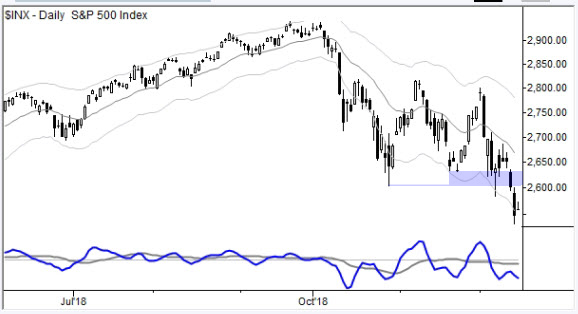I thought it might be useful to take a few moments to look at the technical situation in US stock indexes. Though this is important work, we are only going to scratch the surface. I’ll end this post with a quick look at other things you might want to consider.
First, look at the chart of the S&P 500 (daily, cash index):

I’ve outlined what I have regarded as key support on this index. You might define support differently, but the details are not as important as the broad concept.
And the broad concept is pretty simple: stocks have failed to lift off of support. Each time a level is tested, it’s more likely to break. (This stands in stark contrast to the oft-parroted maxim that a level is more valid the more times it is tested. Price rejection is what makes a level hold, and multiple tests indicate a failure of price rejection; this sets up a likely failure of the level. Don’t believe me? Look at charts and you’ll see…)
We have seen very convincing evidence of the “buy the dip” mentality, whether it’s retail, institutional, or some type of shadowy “plunge protection team.” Every time we’ve gotten into support, there’s been buying… until yesterday.
These are all classic patterns, and they often set up 1) a significant flush (i.e., possibility of mini-crash) below support and 2) a high probability of a longer period of weakness. If you’re still blissfully proceeding in the BTFD mentality, I’d gently suggest you reconsider: that has worked for the last 10 years, but we see here one important piece of evidence that suggests the environment has changed or might be changing.
There’s a very high probability the halcyon days of reliable weekly gains in stocks are behind us. (But this isn’t really something to be scared about; if you have skills you can easily survive the next market phase and even prosper.)
This, by the way, is not really where you want to get bearish. (I said this to my MarketLife Premium clients Monday.) Where you want to get bearish was a few days ago, and to have been holding a bearish bias over the past few weeks. Hindsight, of course, is 20-20, but we also did this correctly in real time! (Hint: you should come and check out MarketLife.)
What else?
The list of things we should consider is almost endless, but let’s hit a few of the usual suspects:
- Other market cap slices. Smaller caps broke down significantly a while back, and never picked up leadership through the summer. Take a look at the Russell 2000 index:

- International indexes: This is something I focus a lot of attention on, and most international indexes have been in bear markets for a while. The US was the lone holdout for a long time.
- Sectors: We’ve seen cyclical and sensitive sectors falter, and strength pour into defensive sectors. This is bearish.
- Commodities: actually, I don’t think we should consider this, but I mention it because many people will suggest it. If you look at longer-term correlations you’ll see the relationships are not simple, and there’s no clear causative link. This is a non-factor in my book.
- Macro and economic factors: Another potentially misleading factor (and this is how a lot of smart people end up doing a lot of bad timing work.) The dirty secret is that the market is THE leading indicator. Economic numbers lag significantly and reliably. Why drive looking in the rear view mirror? Economic data is strong to very strong, with almost no exceptions. It doesn’t matter. This is another factor I would not consider.
- The USD. Trying to predict stocks based on what you think is going to happen to a currency is usually futile, unless you have some clear edge in the currency. (And I don’t think we do here.) All you’re doing is coming up with more ways to lose: you can get currency direction wrong, or you can be right on the currency and the link to stocks doesn’t play out like you expect. Another non-factor (but you’ll hear people talk about it a lot because 1) they don’t have better tools and 2) it sounds smart!)
- Credit spreads and implied volatility: there are very, very few markets that seem to be prescient. Credit spreads are one data point that deserves attention. While everyone (who does not understand the yield curve) is focused on the yield curve, credit spreads have been quietly blowing out. You’ll see major media talking about them at some point in the future, but you should already be watching them.
- Yield curve: non-event. Watch this video.
There are certainly more things we should consider, but this is a short list of factors that I consider (and, yes, discount many of them immediately) in my analysis.
At any rate, technical structures in stock indexes demand attention!
